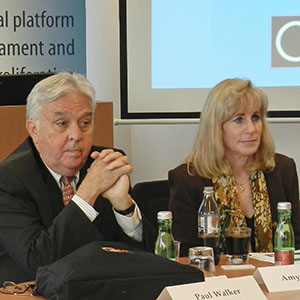
Following the United Nations Secretary-General's report on the 21 August 2013 usage of chemical weapons in the suburbs of Damascus, Syria, experts around the globe have been seeking answers to the many vexing questions: how were these weapons obtained in defiance of the international regulatory regime? And how can the verified elimination of these weapons be ensured?

In an effort to shed some light on these and other questions concerning chemical weapons in Syria and the international efforts being undertaken to eliminate them, on 7 October, 2013, the Vienna Center for Disarmament and Non-Proliferation (VCDNP) hosted a seminar featuring Dr. Amy Smithson, Senior Fellow at the Center for Nonproliferation Studies (CNS) in Monterey, and Dr. Paul Walker, Director of Green Cross International's Environmental Security and Sustainability Program. The event was moderated by VCDNP Executive Director Elena Sokova.

Dr. Amy Smithson began by offering an overview of the history of Syria's chemical weapon program, which initially benefitted from foreign trade, but over time had increasingly become self-sufficient. She then provided a detailed account of Syria's current chemical weapons stockpile, which likely consists of quantities of sarin (or GB), VX, mustard gas, and cyanide. Dr. Smithson presented information on recent cases of suspected chemical weapons use in Syria, which took place around Homs, Aleppo, and Damascus. The most recent attack, on 21 August, saw massive dispersal of mostly sarin on a large scale. She hypothesized that the smaller cases may have been performed by the Bashir Al-Assad regime to "test the waters" of chemical weapons use—both to see how they perform as well as the international community's reaction—though she also offered other alternative hypotheses. Regarding the 21 August attack, she mentioned that the timing of the attack, during which there were low winds and temperatures, caused the chemical agent to remain in place for a longer period of time—this may indicate a high level of expertise and planning by the attacker.
Although Syria has now agreed to the Chemical Weapons Convention (CWC) and the elimination of its chemical weapons stockpile by mid-2014, Dr. Smithson finds a number of key challenges have yet to be overcome—namely, the daunting risk of undeclared facilities and the difficulty in controlling dual-use items. Furthermore, Dr. Smithson referred to the verification experiences in Iraq as an example of the challenges that inspectors may face in verifying the destruction of the Syrian chemical weapons stockpile.

Building on these observations, Dr. Paul Walker discussed some of the inherent difficulties in destroying chemical agents, using the historical examples of the destruction of the stockpiles in the United States and Russia, as well as the challenges to verifying such destruction. He pointed to both the technical and political challenges that have slowed destruction efforts, and reminded the audience that though destruction efforts in the United States and Russia began in the 1990s, to date neither have completely eliminated its stockpile of chemical weapons.
Dr. Walker finds that Syria's chemical weapon stockpile likely will be less challenging to destroy than the US and Russian stockpiles, due to different chemical agents and the likelihood that the Syrian stockpile is less militarized than that of the United States or Russia. However, he noted the lack of resources currently facing the Organisation for the Prohibition of Chemical Weapons (OPCW), which at this time has only around 100 inspectors, and has little capability to deal with such a large-scale destruction verification challenge. To augment this shortfall, the OPCW will likely need additional donations in kind from states with experience destroying chemical weapons stockpiles.
Dr. Walker stressed the importance of the universalization of the CWC, which would provide many advantages including broadening the areas verified to be free of chemical weapons, and expanding the credibility and mandate of the regime. Lastly, Dr. Walker echoed a concern voiced by a member of the audience regarding the security situation in Syria, which is in the midst of a civil war. He called on both the Assad regime and the rebel groups to guarantee the security of the OPCW inspection teams.
